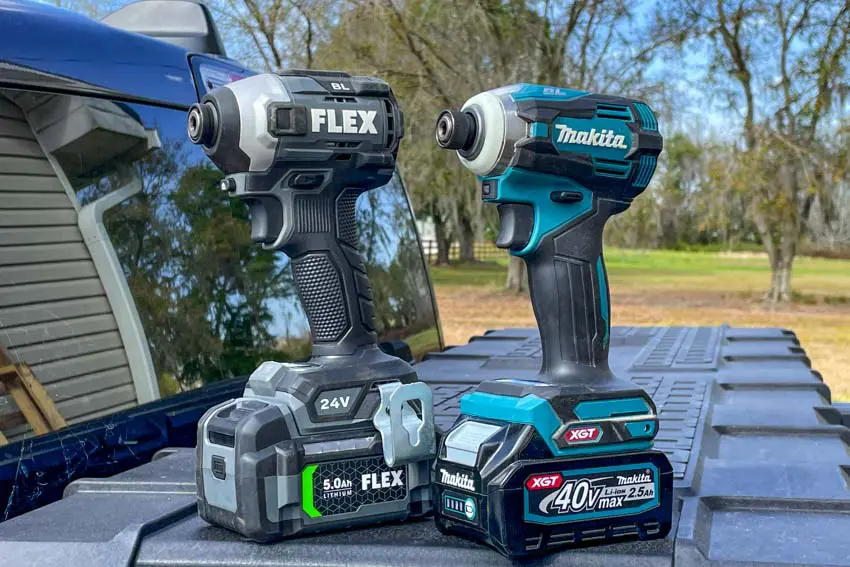Today, we’re taking a closer look at the Flex FX1371 vs the Makita GDT01 impact driver in a head-to-head review. For Flex, it’s the first-generation 24V brushless model that turned heads with its performance claims and features a push-button quick release for the collet. For Makita, it’s the first offering on the high-performance 40V max XGT line.
Neither is the only impact driver for their respective lines. However, they’re both still the performance leaders for them, despite being the first models available.
We’re sharing what we know from testing and research, but the ultimate question is… which one is right for you? Are you going for the highest performance, lowest price, most compact, or something else? Whichever one is the winner in your book, let us know in the comments below!
Check out our best impact driver recommendations for the year!
Flex Vs Makita Impact Driver Specifications
Let’s start with what we can learn from the specifications. Note that because Flex uses a 24V system and Makita is at 40V, there’s not a perfect battery matchup. For Flex, we’re using the weight with a 5.0Ah battery (108Wh). For Makita, it’s the 2.5Ah pack (90Wh).
| Flex FX1371 | Makita GDT01 | |
| Top Speeds | 1900/2700/4000 RPM | 1100/2100/3200/3700 RPM |
| Max Impact Rate | 4450 IPM | 4400 IPM |
| Max Torque | 2500 in-lbs | 1950 in-lbs |
| Head Length | 4.8 in | 4.8 in |
| Bare Weight | 2.8 lbs | 2.2 lbs |
| Weight w/Battery | 4.9 lbs | 3.7 lbs |
Flex Vs Makita Impact Driver Feature Highlights
Flex FX1371

- Brushless motor
- 3 standard peeds
- Self-tapping screw mode
- Quick Eject collet
Makita GDT01

- Brushless motor
- 4 standard speeds
- 2 tightening modes, 1 assist mode, 3 forward/reverse auto-stop modes
- Dual head-mounted LEDs
Flex Vs Makita Impact Driver Test Results
There are three tests we put both impact drivers through to determine their comparative performance. The first is a medium-load test driving a 6-inch x 1/4-inch GRK Fasteners RSS screw into stacked OSB subfloor. The result is the average of three tests.
The second test is timed to see how far each model can drive a 10-inch x 1/2-inch lag screw into the same material in 30 seconds. The result is the average of how much of the screw remained proud in three tests—less is better.
The third test is to see how long it takes to break loose a nut that is set to 150 ft-lbs (1800 in-lbs). The result is the total time added together for 5 bolts.
| Flex FX1371 | Makita GDT01 | |
| RSS Screw Average | 8.7 seconds | 12.8 seconds |
| Lag Screw Average | 3.1 inches | 3.5 inches |
| Nut-Busting Total | 3.2 seconds | 6.0 seconds |
What if you have access to advanced batteries? We tested those, too! Flex has a Stacked Lithium pouch cell battery available. However, Makita does not currently have an upgrade (though its standard batteries are quite a bit more advanced than some).
| Flex FX1371 w/6.0Ah Stacked Lithium | Makita GDT01 w/2.5Ah | |
| RSS Screw Average | 5.9 seconds | 12.8 seconds |
| Lag Screw Average | 0.7 inches | 3.5 inches |
| Nut-Busting Total | 2.3 seconds | 6.0 seconds |
Flex Vs Makita Impact Driver Price
| Flex FX1371 | Makita GDT01 | |
| Bare Tool | $159.00 | $217.00 |
| Standard Battery Kit | $249.00 (2.5Ah and 5.0Ah) | $429.00 (2 x 2.5Ah) |
| Advanced Battery Kit | $279.00 (6.0Ah Stacked Lithium) | Not Available |
| Warranty | 5 years (lifetime with registration) | 3 years |
So who’s your winner? Let us know in the comments below—bonus points for telling us why!



